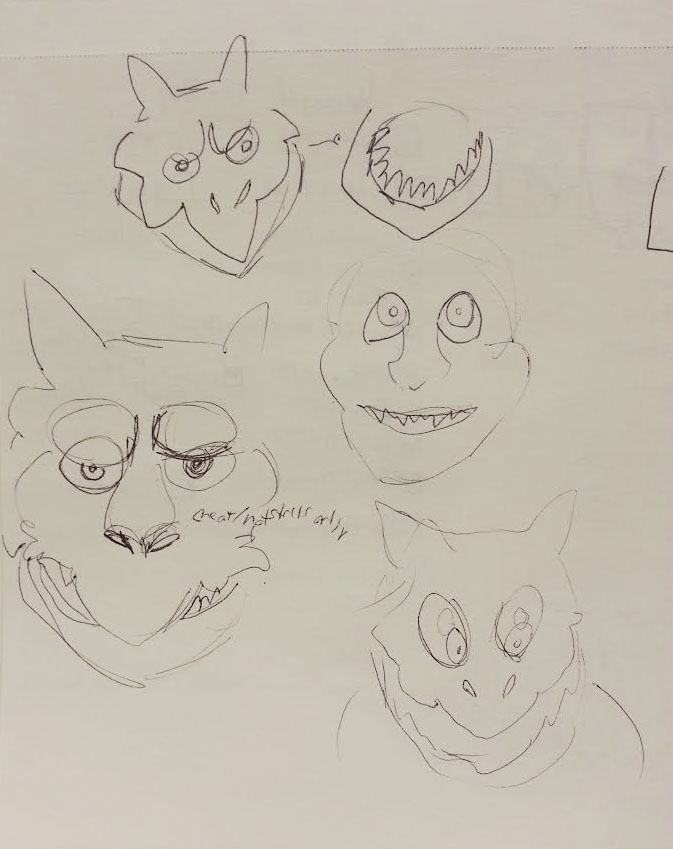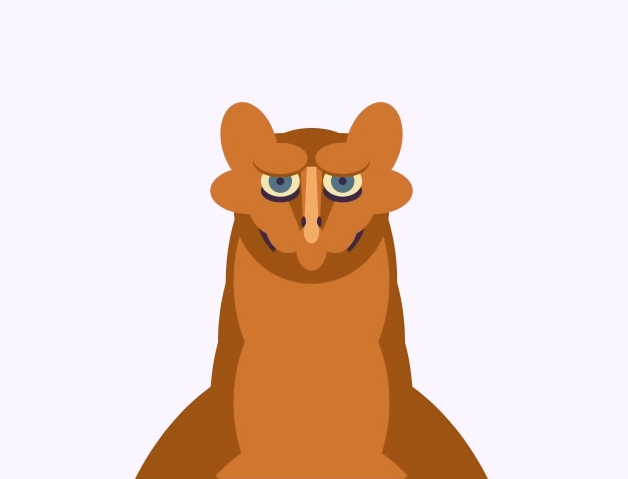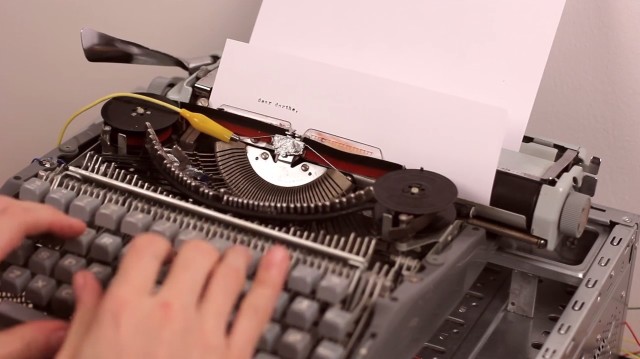FaceOSC: The Orange Gobbler
My goal was to create a creature with expressive eyes and an expressive mouth. I tracked the positions of the left eye, right eye, left eyebrow, right eyebrow, the nostrils, and the jaw. I decided to work with primitives so I could easily be able to see what motions were changing which shapes.
The body was a bit of an afterthought, and it acts a bit like a slinky due to how the position of the jaw was used in placing shapes. If I were to revisit this project, I’d try to utilize some of the mouth parameters to make the creature more expressive. However, I’m undecided on whether or not to give “The Orange Gobbler” a set of teeth.
 At one point, The Orange Gobbler did have highlights in its eyes, but for some reason the highlights made the Gobbler look a bit too unsettling.
At one point, The Orange Gobbler did have highlights in its eyes, but for some reason the highlights made the Gobbler look a bit too unsettling.
//Miranda Jacoby
//EMS Inetractivity Section A
//majacoby@andrew.cmu.edu
//Creature design is copyright Miranda Jacoby 2014
//Adapted from Golan Levin's "FaceOSCReceiver" program
// Don't forget to install OscP5 library for Processing,
// or nothing will work!
//
// A template for receiving face tracking osc messages from
// Kyle McDonald's FaceOSC https://github.com/kylemcdonald/ofxFaceTracker
import oscP5.*;
OscP5 oscP5;
// num faces found
int found;
// pose
float poseScale;
PVector posePosition = new PVector();
PVector poseOrientation = new PVector();
// gesture
float mouthHeight;
float mouthWidth;
float eyeLeft;
float eyeRight;
float eyebrowLeft;
float eyebrowRight;
float jaw;
float nostrils;
//dimensions
float nostrilHeight;
void setup() {
size(640, 480);
frameRate(30);
oscP5 = new OscP5(this, 8338);
oscP5.plug(this, "found", "/found");
oscP5.plug(this, "poseScale", "/pose/scale");
oscP5.plug(this, "posePosition", "/pose/position");
oscP5.plug(this, "poseOrientation", "/pose/orientation");
oscP5.plug(this, "mouthWidthReceived", "/gesture/mouth/width");
oscP5.plug(this, "mouthHeightReceived", "/gesture/mouth/height");
oscP5.plug(this, "eyeLeftReceived", "/gesture/eye/left");
oscP5.plug(this, "eyeRightReceived", "/gesture/eye/right");
oscP5.plug(this, "eyebrowLeftReceived", "/gesture/eyebrow/left");
oscP5.plug(this, "eyebrowRightReceived", "/gesture/eyebrow/right");
oscP5.plug(this, "jawReceived", "/gesture/jaw");
oscP5.plug(this, "nostrilsReceived", "/gesture/nostrils");
nostrilHeight = 7;
}
void draw() {
background(249, 245, 255);
stroke(0);
if(found > 0) {
translate(posePosition.x, posePosition.y);
scale(poseScale);
noStroke();
//Legs
fill(155, 84, 14);
pushMatrix();
rotate(6.25);
ellipse(20, jaw * 20, 125, 200);
popMatrix();
pushMatrix();
rotate(-6.25);
ellipse(-20, jaw * 20, 125, 200);
popMatrix();
//Neck and Body
fill(155, 84, 14);
ellipse(0, jaw * 3, 110, 180);
ellipse(0, jaw * 5, 120, 190);
ellipse(0, jaw * 7, 130, 200);
ellipse(0, jaw * 9, 140, 210);
ellipse(0, jaw * 11, 150, 220);
ellipse(0, jaw * 15, 275, 375);
fill(206, 119, 48);
ellipse(0, jaw * 3, 100, 150);
ellipse(0, jaw * 7, 100, 150);
ellipse(0, jaw * 11, 100, 150);
ellipse(0, jaw * 15, 200, 275);
//Arms
fill(155, 84, 14);
pushMatrix();
rotate(6);
ellipse(20, jaw * 15, 125, 200);
popMatrix();
pushMatrix();
rotate(-6);
ellipse(-20, jaw * 15, 125, 200);
popMatrix();
//Mouth Lower Jaw
fill(155, 84, 14);
ellipse(0, jaw * .5, 100, 100);
fill(58, 42, 72);
ellipse(0, jaw * .5, 73, 80);
//Mouth Lower Jaw Tip
fill(155, 84, 14);
ellipse(0, jaw * 2.25, 50, 30);
//Space Between the Eyes (CHECK FOR OVERLAP PROBLEMS)
fill(155, 84, 14);
ellipse(0, 10 * -2.7, 35, 20);
ellipse(-20, 10 * -2.7, 35, 20);
ellipse(20, 10 * -2.7, 35, 20);
ellipse(-20, 5 * -2.7, 35, 20);
ellipse(20, 5 * -2.7, 35, 20);
quad(-20, eyeLeft * -10, 20, eyeRight * -10, 5, (nostrils + nostrilHeight * .5) * 3, -5, (nostrils + nostrilHeight * .5) * 3);
//Horns
fill(206, 119, 48);
pushMatrix();
rotate(6);
ellipse(-30, -40, 35, 55);
popMatrix();
pushMatrix();
rotate(-6);
ellipse(30, -40, 35, 55);
popMatrix();
fill(155, 84, 14);
ellipse(-20, 0, 50, 30);
ellipse(20, 0, 50, 30);
fill(206, 119, 48);
ellipse(-40, 0, 50, 30);
ellipse(40, 0, 50, 30);
//Mouth Upper Jaw
fill(206, 119, 48);
pushMatrix();
rotate(-5);
ellipse(-0, 30, 40, 25);
popMatrix();
pushMatrix();
rotate(5);
ellipse(0, 30, 40, 25);
popMatrix();
pushMatrix();
//rotate(-5);
ellipse(15, 20, 30, 40);
popMatrix();
pushMatrix();
//rotate(5);
ellipse(-15, 20, 30, 40);
popMatrix();
// ellipse(0, jaw * .5, 100, 100);
// ellipse(0, jaw * 2.5, 50, 30);
//Bridge of Nose
fill(155, 84, 14);
quad(-20, eyeLeft * -2, 20, eyeRight * -2, 5, (nostrils + nostrilHeight + (jaw * -2.5)/15) * 3, -5, (nostrils + nostrilHeight + (jaw * -2.5)/15) * 3);
fill(206, 119, 48);
quad(-20 + 27, eyeLeft * -5, 20 - 27, eyeRight * -5, -5, (nostrils + nostrilHeight + (jaw * -2.5)/15) * 3, 5, (nostrils + nostrilHeight + (jaw * -2.5)/15) * 3);
fill(240, 172, 104);
quad(-30 + 27, eyeLeft * -5, 30 - 27, eyeRight * -5, 5, (nostrils + nostrilHeight + (jaw * -2.5)/15) * 3, -5, (nostrils + nostrilHeight + (jaw * -2.5)/15) * 3);
//Eye Bags
//fill(206, 119, 48);
fill(58, 42, 72);
ellipse(-20, 0, 25, 15);
ellipse(20, 0, 25, 15);
//Eye Sclera
fill(245, 229, 175);
ellipse(-20, eyeLeft * -2, 25, 20);
ellipse(20, eyeRight * -2, 25, 20);
//Eye Iris
fill(84, 115, 134);
ellipse(-20, eyeLeft * -2, 15, 15);
ellipse(20, eyeRight * -2, 15, 15);
//Eye Pupil
fill(58, 42, 72);
ellipse(-20, eyeLeft * -2, 5, 5);
ellipse(20, eyeRight * -2, 5, 5);
//Eye Highlight
//fill(255, 253, 234);
//ellipse(-27, eyeLeft * -2.5, 4, 2);
//ellipse(13, eyeRight * -2.5, 4, 2);
//Mouth?
//ellipse(0, 20, mouthWidth* 3, mouthHeight * 3);
//Nostrils
fill(58, 42, 72);
ellipse(-5, nostrils * 3, 3, nostrilHeight);
ellipse(5, nostrils * 3, 3, nostrilHeight);
//Mouth Upper Jaw Tip
fill(206, 119, 48);
ellipse(0, 80 + jaw * -2.25, 20, 30);
fill(240, 172, 104);
ellipse(0, 70 + jaw * -2.25, 10, 15);
//ellipseMode(CENTER);
//Eyebrows
fill(155, 84, 14);
pushMatrix();
ellipse(-20, eyebrowLeft * -2.7, 35, 20);
popMatrix();
pushMatrix();
ellipse(20, eyebrowRight * -2.7, 35, 20);
popMatrix();
fill(206, 119, 48);
pushMatrix();
ellipse(-20, eyebrowLeft * -3, 35, 20);
popMatrix();
pushMatrix();
ellipse(20, eyebrowRight * -3, 35, 20);
popMatrix();
}
}
// OSC CALLBACK FUNCTIONS
public void found(int i) {
println("found: " + i);
found = i;
}
public void poseScale(float s) {
println("scale: " + s);
poseScale = s;
}
public void posePosition(float x, float y) {
//println("pose position\tX: " + x + " Y: " + y );
posePosition.set(x, y, 0);
}
public void poseOrientation(float x, float y, float z) {
//println("pose orientation\tX: " + x + " Y: " + y + " Z: " + z);
poseOrientation.set(x, y, z);
}
public void mouthWidthReceived(float w) {
//println("mouth Width: " + w);
mouthWidth = w;
}
public void mouthHeightReceived(float h) {
//println("mouth height: " + h);
mouthHeight = h;
}
public void eyeLeftReceived(float f) {
//println("eye left: " + f);
eyeLeft = f;
}
public void eyeRightReceived(float f) {
//println("eye right: " + f);
eyeRight = f;
}
public void eyebrowLeftReceived(float f) {
//println("eyebrow left: " + f);
eyebrowLeft = f;
}
public void eyebrowRightReceived(float f) {
//println("eyebrow right: " + f);
eyebrowRight = f;
}
public void jawReceived(float f) {
println("jaw: " + f);
jaw = f;
}
public void nostrilsReceived(float f) {
//println("nostrils: " + f);
nostrils = f;
}
// all other OSC messages end up here
void oscEvent(OscMessage m) {
/* print the address pattern and the typetag of the received OscMessage */
println("#received an osc message");
println("Complete message: "+m);
println(" addrpattern: "+m.addrPattern());
println(" typetag: "+m.typetag());
println(" arguments: "+m.arguments()[0].toString());
if(m.isPlugged() == false) {
println("UNPLUGGED: " + m);
}
}






